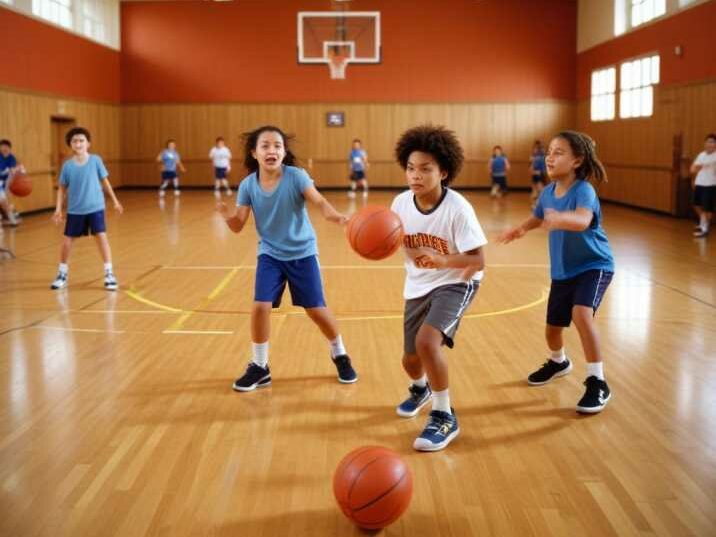Introduction to Kids Dodgeball
Table of Contents
Dodgeball is a fun, fast-paced game that’s perfect for kids. It promotes physical activity, teamwork, and sharpens motor skills while ensuring kids have a blast. Ideal for PE classes, birthday parties, and after-school activities, dodgeball keeps children engaged and excited.

Why Dodgeball? Benefits for Kids:
Physical Fitness
Physical fitness is a key benefit of playing dodgeball, especially for children. The game’s fast pace requires kids to run, jump, and throw, which engages multiple muscle groups and ensures a comprehensive workout. This activity helps build cardiovascular endurance, muscular strength, and coordination.
Teamwork and Social Skills
Dodgeball is an excellent way for kids to develop teamwork and social skills. Playing in teams necessitates communication, cooperation, and strategic planning. By working together toward a common goal, children learn important social interactions such as sharing, supporting teammates, and resolving conflicts, which are crucial skills both on and off the court.
Improved Focus
The quick pace of dodgeball demands constant attention and rapid decision-making. As kids track the ball, anticipate opponents’ actions, and execute their own strategies, they enhance their concentration, reflexes, and overall cognitive abilities. This heightened focus extends beyond the playing field, benefiting academic and everyday activities.
Fun and Engagement
The exhilarating nature of dodgeball makes it highly engaging for children. The combination of teamwork, strategy, and physical exertion creates an enjoyable environment where kids can have fun while being active. This positive experience fosters a lifelong interest in physical fitness and group activities.
How to Play Dodgeball
Basic Rules:
- Objective: The main goal is to eliminate players of the opposing team by hitting them with a ball or catching their throws.
- Teams: Split the kids into two teams, each occupying one half of the playing area.
- Game Start: Place the balls along the center line. Players start on their end lines and rush to the center to grab a ball at the whistle.
- Gameplay:
- Players throw balls at opponents to try and hit them below the shoulders.
- A hit player is out and must leave the playing area.
- If a player catches a ball thrown by an opponent, the thrower is out, and the catching team can bring back one of their eliminated players.
- Winning: The game continues until all players on one team are eliminated. The last team standing wins the round.
The basic rules of kids dodgeball are straightforward and are designed to keep the game fun and safe for all participants. The primary objective is to eliminate players on the opposing team by striking them with a ball or by catching a ball thrown by them. There are typically two teams, each occupying one half of the playing area, with the game beginning when players rush to the centre line to collect the balls placed there.
Players aim to hit their opponents below the shoulders to avoid injuries. If a player is hit, they are considered out and must leave the playing area. Conversely, if a player catches an opponent’s throw, the thrower is out, and the catcher’s team gets to bring back one player who was previously eliminated. The game proceeds until one team has no remaining players, at which point the other team is declared the winner.

Kids Dodgeball Variations
There are numerous variations of dodgeball specifically designed to keep the game interesting and suitable for different age groups and skill levels. These variations often modify the basic rules to either simplify the game for younger kids or add layers of strategy for older children. Examples include “Doctor Dodgeball,” where a designated “doctor” can revive eliminated players, or “Circle Dodgeball,” where players form a circle around a designated target player. These variations ensure that dodgeball remains an adaptable and inclusive activity that can be enjoyed by all children.
Safety Tips for Kids Dodgeball:
Soft Balls
Using soft, lightweight balls is crucial for the safety of kids playing dodgeball. These balls are designed to minimize the risk of injury upon impact, allowing children to participate without fear of getting hurt. The reduced weight and softer material ensure that even high-speed throws are safe, making the game enjoyable for all. Soft balls help create a positive environment where kids can focus on their skills and teamwork rather than worrying about potential injuries.
No Headshots
Implementing a “no headshots” rule is essential to maintain a safe and fair game. This rule mandates that players must avoid aiming for the head when throwing the ball to prevent injuries, especially to the face and head. Clear communication about this rule ensures that all participants understand the importance of aiming lower, typically below the shoulders. Enforcing this rule helps to foster a more controlled and respectful game environment where safety is prioritized.
Supervision
Having adult supervision during a dodgeball game is vital for several reasons. Supervisors ensure that all rules are being followed and can intervene if the game becomes too rough or if disputes arise. Their presence helps to maintain order and fairness, ensuring that the game runs smoothly. Additionally, adult supervisors can provide immediate assistance in the event of an injury or other issue, enhancing the overall safety and enjoyment of the game.
Variations of Dodgeball
To keep the game exciting and accommodating for different skill levels, try these variations:
- Doctor Dodgeball: Each team has a “doctor” who can “heal” eliminated players by touching them. The game ends when the opposing team’s doctor is hit.
- Four Quadrants: Divide the playing area into four zones. Teams can only move within their quadrant, adding a strategic element to the game.
- Opposite Hand Dodgeball: Players must throw with their non-dominant hand, making the game more challenging and fair.
Conclusion
Kids dodgeball is more than just a game—it’s a fantastic way to encourage physical fitness, teamwork, and strategic thinking in a fun, engaging environment. Whether played in schools, during parties, or in community centers, dodgeball remains a timeless favorite among kids.
Want to organize a dodgeball event for your kids? Contact us today for tips, equipment, and more!
FAQs
1. What are the basic rules of dodgeball?
The basic rules of dodgeball include aiming to hit opponents with a ball below the shoulders to eliminate them, catching an opponent’s throw to eliminate the thrower and bringing back a previously eliminated teammate, and playing until all players on one team are eliminated.
2. Is dodgeball safe for young children?
Yes, dodgeball can be safe for young children if proper safety measures are followed, such as using soft balls, enforcing a no headshots rule, and ensuring adult supervision.
3. What variations of dodgeball can we play?
Some popular variations include Doctor Dodgeball, where a designated “doctor” can revive eliminated players, Four Quadrants, which adds a strategic element by restricting movement to specific zones, and Opposite Hand Dodgeball, where players must throw with their non-dominant hand.
4. How can we ensure the safety of children playing dodgeball?
Safety can be ensured by using soft, lightweight balls, enforcing the no headshots rule, and having responsible adult supervision during the game to manage the rules and handle any issues promptly.
5. Can dodgeball be played indoors and outdoors?
Yes, dodgeball can be played both indoors and outdoors. The playing area should be spacious and void of obstacles to ensure safe play regardless of the setting.


